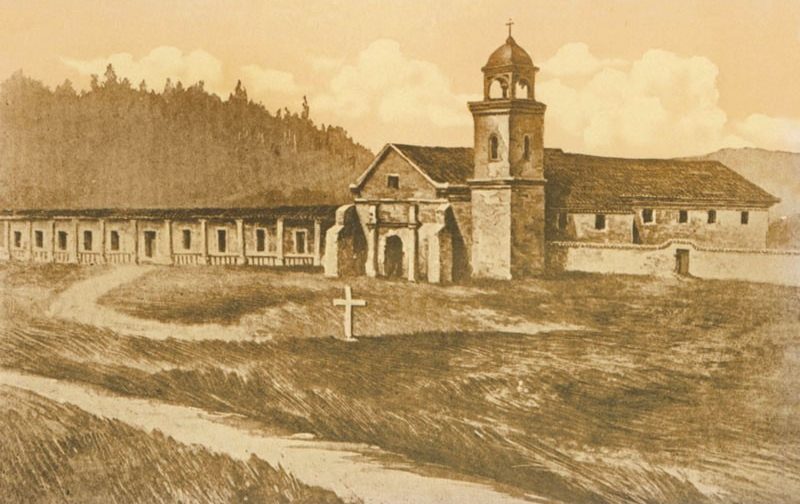Mission Santa Cruz, located in the city of Santa Cruz, near the mouth of the San Lorenzo River, was the twelfth mission in the chain. It was founded on August 28, 1791, by Father Fermín Francisco de Lasuén and dedicated a month later, on September 25. Fathers Isídro Alonzo Salazar and Baldomero López were appointed as the first missionaries in charge of the mission. The initial site chosen for building the mission was located on the bottom of what would become Mission Hill, near what is today the intersection of River Street and North Pacific Avenue.
As soon as winter arrived, the Spanish Fathers realized that the area was prone to flooding. For the next two years, until 1793, they worked to relocate the mission to the top of the hill. The first permanent church, completed in 1794, was 112 feet long, 29 feet wide, and 25 feet high, with walls five feet thick. Other buildings were soon erected, including a grain mill in 1796, and the mission enclosed a hollow square. Although started in favorable conditions, a series of misfortunes prevented Mission Santa Cruz from real success and prosperity.
The total population of the mission reached five hundred at its height in 1796. The greatest problem was the nearby Pueblo of Branciforte, which was colonized by vagabonds and criminals. These early colonists were the opposite of “upright, God-fearing men”. Villa de Branciforte was established in 1797 as a secular Pueblo by California Governor Diego de Borica. The Pueblo was located on the other side of the San Lorenzo River, facing Santa Cruz Mission.
On October 12, 1812, Father Andrés Quintana, one of the Franciscan Fathers who at the time lived at the mission, was murdered by a group of mission neophytes. Quintana was strangled to death during the night as revenge for its brutal use of metal-tipped whips as a means of punishment. In an interview dated 1877, Lorenzo Asisara, son of one of the neophytes who plotted the assassination of Father Quintana and a neophyte at Santa Cruz himself, narrated the story his father had told him about this cruel event.
In 1818, fearing an imminent attack by Argentine privateer Hipólito Bouchard, the mission was evacuated. The citizens of Branciforte were entrusted with safeguarding the mission’s valuables but instead, they looted many of the remaining items left at Santa Cruz. The whole situation put a strain on the Padres trying to convert the local Indians.
All the original buildings have disappeared except for a long building of 1822 which at the time housed the families of converted neophytes from the local Ohlone and Yokuts tribes. The building is now part of the Santa Cruz Mission State Historical Park, is located at 144 School Street, and is indeed worth a visit. Also, a section of the stone foundation wall from one of the mission buildings and a few old headstones from the mission cemetery can be found just behind the present Holy Cross Church.
In 1840, the bell tower of the Mission fell over and the rest of the original mission buildings were damaged due to an earthquake. In 1857, the already weakened buildings collapsed nearly completely during the Fort Tejon earthquake. At the time, the Santa Cruz mission had nine or ten bells, valued more than any others in the mission chain. The whereabouts of these bells remain a mystery. Just a year later, in 1858, a wooden church was erected, replacing the original adobe structure. In 1889, the wooden church was replaced with the Gothic church that still stands today and is known as Holy Cross Church.
For almost 75 years, the original Mission Santa Cruz seemed lost forever. But in 1931, a one-half-sized replica of the original mission was completed. The building of this beautiful replica was made possible by Gladys Sullivan Doyle. She proposed the idea and contributed to all of the construction costs on the condition that she would be buried inside the mission. Today, the lady rests in a small side room inside the mission replica. The rebuilt Mission Santa Cruz stands not far from its original location, today occupied by the Holy Cross Church.
The people who built the one-half-sized mission replica spent quite a lot of time looking at old books and pictures so that the new replica would resemble the original mission as much as possible. Unfortunately, not much was left. In the end, a painting made by French artist Léon Trousset in the 1850s proved to be of fundamental importance in reconstructing the mission. The sepia postcard at the top of this page comes from the Cardinell Vincent collection and is a photograph of the painting of Trousset. The original painting is still hanging at the Misión Galería Gift Shop. The Galería is also a small museum with relics of the early mission days and a collection of beautiful vestments worn by the Padres.
Location of Mission Santa Cruz
120 Emmett Street, Santa Cruz, CA 95060, United States
